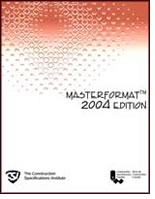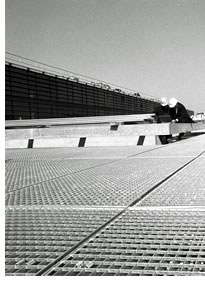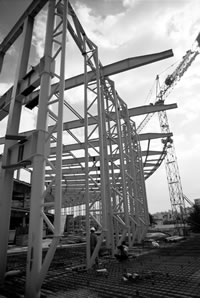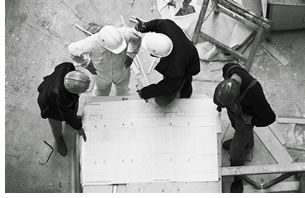

12/2004
 by
Edward F. (Ted) Smith, FAIA, president, ARCOM
by
Edward F. (Ted) Smith, FAIA, president, ARCOM
The Construction Specifications Institute (CSI) recently released its 2004 edition of MasterFormat, which is a total revamping of the 1995 edition of its industry-standard classification system for construction-related products and processes. Although this revision is a normal update on the part of CSI, the 2004 edition is a dramatic improvement. MASTERSPEC will begin an implementation of the new system beginning mid-year 2005.
Strategically, this expansion of CSI MasterFormat divisions is a good move for an industry that increasingly communicates electronically and across applications, and which seeks interoperability among the design professions and construction trades. The A/E/C professions and industry needed both more room to expand as new technologies and systems develop and a consistent standard framework for that expansion.
Admittedly, though, tactically this is difficult for all of us to swallow. It will take time and work to make the transition from 16 divisions to 50. For instance, at ARCOM, we have to change every number and many of the titles of MASTERSPEC sections because of the new numbering system and the fact that some sections have now been split or combined in the new system. By the middle of the coming year, MASTERSPEC will be available in both the 1995 and 2004 versions of MasterFormat. MASTERSPEC users can choose whether to continue to use 1995 and then convert when they think it is best for their firm.
 MasterFormat
is a de
facto standard, not a governmental regulation,
so no one has to adopt it. But we believe, as do our partners, competitors,
and other information providers, that it is in the industry’s best interest
to do so. Toward that end, we had representatives at all of the CSI MasterFormat
expansion task team meetings to make sure that the new system made sense
from the perspective of our MASTERSPEC users.
MasterFormat
is a de
facto standard, not a governmental regulation,
so no one has to adopt it. But we believe, as do our partners, competitors,
and other information providers, that it is in the industry’s best interest
to do so. Toward that end, we had representatives at all of the CSI MasterFormat
expansion task team meetings to make sure that the new system made sense
from the perspective of our MASTERSPEC users.
MASTERSPEC is a product of the AIA, and as publisher of that system, ARCOM is—by history, contract, and commitment—an AIA partner. We are taking on as much of the burden of conversion as we can for MASTERSPEC users. For instance, our software will be updated so it will recognize whether a particular specification is following the 1995 or 2004 MasterFormat version and will display the appropriate table of contents and numbering system. We will also provide user training necessary for the adoption of MasterFormat 2004.
We already have a map available to MASTERSPEC users that shows the relation between the 1995 and 2004 versions so users can begin planning for the conversion in their offices, particularly where they have office masters. Nevertheless, I know that many firms are going to have a big effort converting to the 2004 version, particularly if they have extensive office masters, standard details, and keynotes that use the 1995 numbers.
 Information providers are likewise in a transitional mode to meet the
new demands—and opportunities—of the new CSI system. This
will, of necessity, require a transition period. For example, MASTERSPEC
currently links to Sweet’s, which uses MasterFormat 1995. So if
we, or others who reference Sweet’s directly, were to change before
they make their conversion, users may have difficulty finding certain
categories of products using the new numbering system. The industry must
move in a coordinated progression, a task we are already undertaking.
Information providers are likewise in a transitional mode to meet the
new demands—and opportunities—of the new CSI system. This
will, of necessity, require a transition period. For example, MASTERSPEC
currently links to Sweet’s, which uses MasterFormat 1995. So if
we, or others who reference Sweet’s directly, were to change before
they make their conversion, users may have difficulty finding certain
categories of products using the new numbering system. The industry must
move in a coordinated progression, a task we are already undertaking.
All of the master specification providers and product information suppliers in the U.S. and Canada have announced that they are going to adopt MasterFormat 2004 in the next two years. 4specs.com already has their Web site in both MasterFormat versions, so users can search by either numbering system.
What the change is all about
Many firms have indicated that they won’t change until the clients ask them to. I sense some apprehension about the 2004 MasterFormat because people do not know what the changes will be and how they will make the new system work better for them.
 Divisions 3 through 14 remain intact. But before I outline the substantive
changes that were made in other divisions, let me explain the need we
saw for an expanded specifications categorization system.
Divisions 3 through 14 remain intact. But before I outline the substantive
changes that were made in other divisions, let me explain the need we
saw for an expanded specifications categorization system.
In recent years, as building systems and related product lines have expanded, ARCOM has had some difficulty finding locations in which to place some of the topics in MASTERSPEC. We have not been alone in this dilemma, and the other large information providers that use MasterFormat—such as Sweet’s, First Source, and 4specs—have all had to assign their own numbers at the more detailed levels (particularly level 4). And there has been no centralized coordination for those number assignments.
This became a particularly vexing issue as electronic connections among our users began to burgeon. For instance, we found that to send our users to Sweet’s or to First Source to look for products, we needed to map our level-four numbers to their level-four numbers so we could get users seamlessly to the right locations. Efficiency suffered.
The second issue is that, until the 2004 edition, the whole mechanical and electrical areas have been stuffed into divisions 15 and 16, respectively. These areas were very tight with regard to available numbers when we tried to fit in new systems and materials. In addition, civil engineering had no separate division. Most of the civil work was put in division 2, Site Work, because civil work tends to be site related.
 Third, there are only five digits to represent information in different
levels of specificity. One digit each in levels two, three, and four
meant we could only have 9 different topics in each. We were running
out of numbers for some topics.
Third, there are only five digits to represent information in different
levels of specificity. One digit each in levels two, three, and four
meant we could only have 9 different topics in each. We were running
out of numbers for some topics.
In addition, there had been efforts by different organizations to capture a “division 17.” Some were using it for communications or for fire suppression. There was no uniformity. We had no place to put some of the newer building automation systems, such as control, security, and automation of systems. There wasn’t a good place in the 1995 MasterFormat to put performance specifications or operations and maintenance data. There really wasn’t a place for the specification of things like infrastructure, waste- and water-treatment facilities, or electrical distribution networks. The 2004 MasterFormat now addresses these areas and provides adequate room for continuing expansion in the coming years.
Here’s what has changed
The 2004 MasterFormat replaces the five-digit numbering system with six digits, with the potential for an eight-digit system at level 4.
Essentially, the 2004 MasterFormat leaves the Facilities Construction divisions (3-14) intact, with the only major changes there being:
- Division 2 is now existing conditions only. For example, it addresses all of the issues about site remediation, such as hazardous soils.
- Site improvements, including all of the site civil engineering work, was moved to a separate group of divisions, the new 30 series.
- Division 6 was renamed from “Wood and Plastics” to “Wood, Plastics, and Composites” to recognize all the composite materials now available for buildings.
- Division 8 was renamed from “Doors and Windows” to “Openings” to accommodate other types of openings.
Mechanical and electrical, formerly divisions 15 and 16 now are in a new series, the 20s, called “Facility Services.” This series has reserved divisions, which leaves room for future expansion. Facility Services is now broken down into fire suppression, plumbing, HVAC, integrated automation, (divisions 21-24), and electrical systems, communications, and electronic safety and security (divisions 26-28). The new 30 series, Site and Infrastructure, comprises earthwork, exterior improvements, utilities, transportation, and water and marine construction (Divisions 31-35).
 The
40 series may not heavily impact A/E/C-related specifications because
it is set aside for the specification of process equipment, such as for
manufacturing, chemical plants, and refineries. Two divisions in the
40 series that may be of interest are pollution control and electrical
generation, which are in this subgroup because they are an integral part
of many manufacturing facilities.
The
40 series may not heavily impact A/E/C-related specifications because
it is set aside for the specification of process equipment, such as for
manufacturing, chemical plants, and refineries. Two divisions in the
40 series that may be of interest are pollution control and electrical
generation, which are in this subgroup because they are an integral part
of many manufacturing facilities.
Will implementation of a transition to the new MasterFormat be easy? No. Will the resultant increases in efficiency and improvements in electronic cross-application communication make the transition well worth the cost and time investments necessary? In our opinion, a most definite yes.
Copyright 2004 The American Institute of Architects.
All rights reserved. Home Page ![]()
![]()
 |
||
For another discussion of how MASTERSPEC will implement MasterFormat 2004, go to the article in the current SpecPress newsletter written by Christopher Bushnell, AIA, ARCOM director of MASTERSPEC Operations. The MasterFormat 2004 numbers and titles are available at www.csinet.org/masterformat AIA Convention to Offer MF CE
|
||